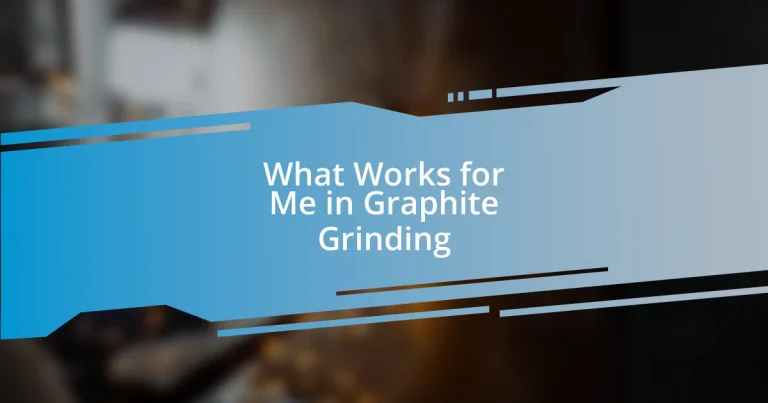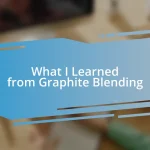Key takeaways:
- Understanding graphite’s layered structure and properties is essential for effective machining and selecting the right type for specific applications.
- Choosing appropriate grinding equipment, including grinder type, blade material, and dust collection systems, is crucial for optimal results.
- Implementing techniques like stepwise grinding, using coolants, and maintaining a consistent pace enhances efficiency and quality in graphite grinding.
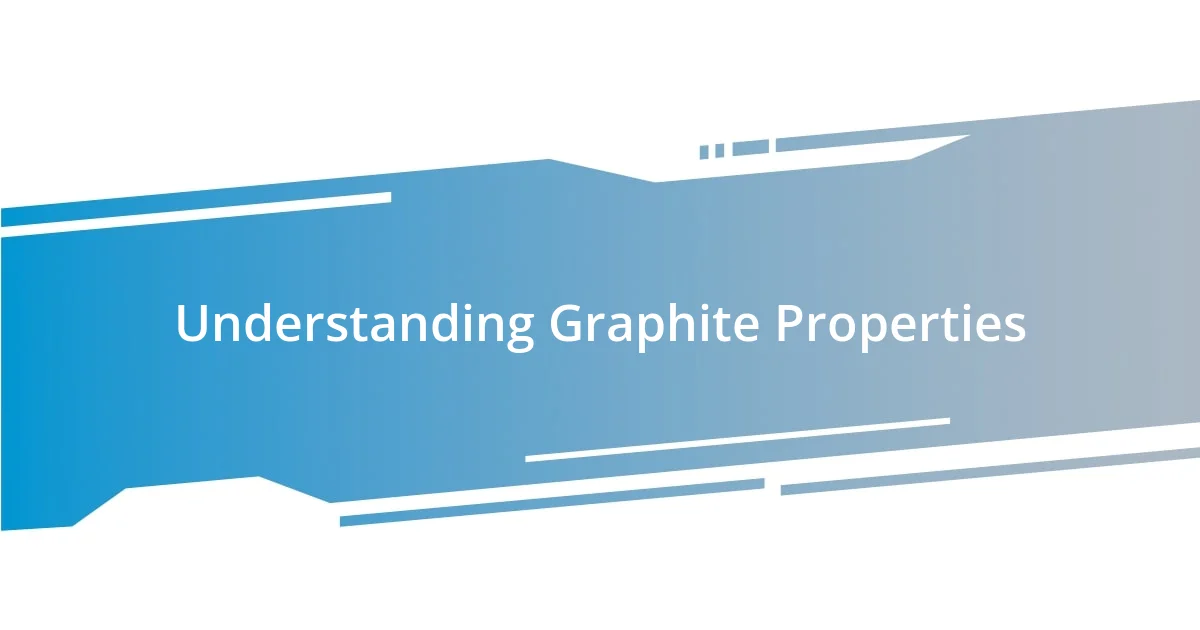
Understanding Graphite Properties
Understanding the properties of graphite is crucial when you’re involved in grinding it. Graphite is fascinating because it’s not just soft and slippery; it actually occurs in different grades that significantly affect its behavior during machining processes. I still remember my first encounter with different graphite grades—how some felt like fine talcum powder, while others were perfectly coarse and gritty.
What strikes me most is how graphite’s structure contributes to its properties. It’s layered, which allows easy cleavage along those planes, making it ideal for lubrication and conductivity. Have you ever noticed the way graphite pencils glide on paper, leaving a smooth mark? That’s not just chance; it’s the unique arrangement of atoms that creates that effortless flow.
Moreover, the thermal and electrical conductivity of graphite can’t be overlooked. It’s incredible how it can efficiently transfer heat and electricity while being a non-metal. I once thought about this while working on a project that required precise temperature control. Why does it matter? Because understanding these properties helps us choose the right type of graphite for specific applications, ultimately making our work more efficient and effective.

Choosing the Right Equipment
Choosing the right equipment for graphite grinding is essential for achieving optimal results. In my experience, the right tools can make all the difference. I remember the first time I upgraded my grinding setup—what a game changer! The improved consistency and quality of the finished material reminded me how vital it is to invest in quality gear.
Here are some factors to consider when selecting your equipment:
- Type of Grinder: Choose between ball mills, hammer mills, or roller mills based on the desired particle size and shape.
- Blade Material: Opt for hardened steel or tungsten carbide blades to withstand wear and tear.
- Speed and Power: Higher RPMs can increase efficiency, but too much power can generate heat, affecting graphite’s properties.
- Dust Collection System: Effective filtration is crucial to maintain a safe work environment and avoid contamination.
- Adjustability: Look for equipment that allows you to fine-tune settings according to specific graphite grades.
Selecting the right equipment should align with your specific needs and the unique challenges of working with graphite. There’s something incredibly satisfying about finding just the right tool that turns a tricky task into a breeze; I often feel like a kid in a candy store when I discover new options!
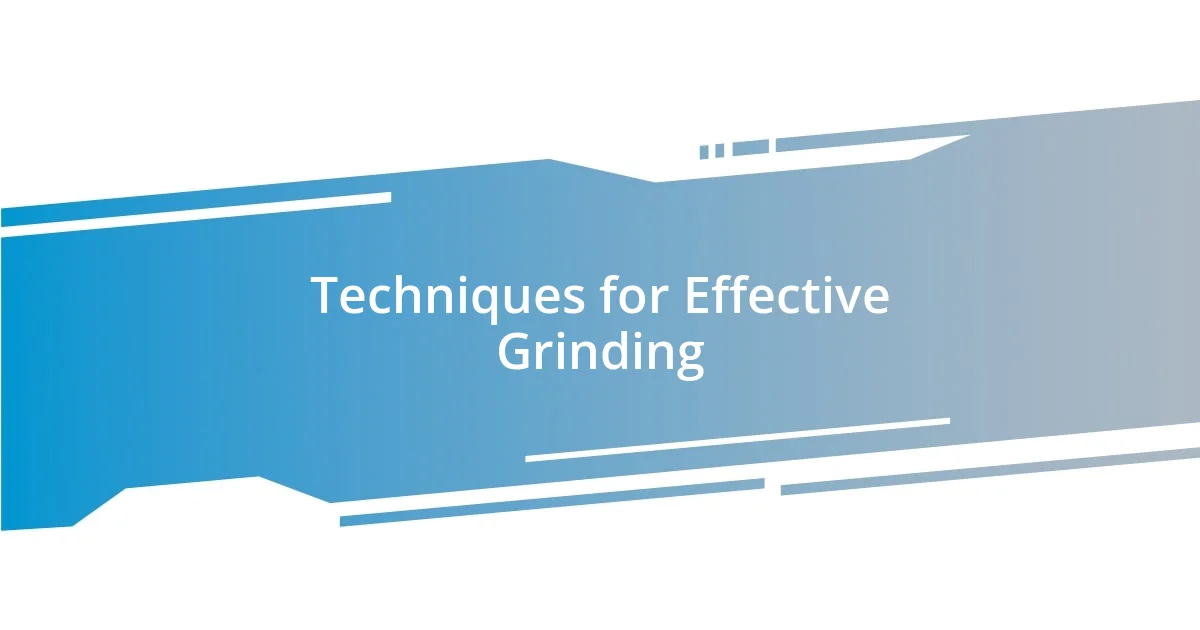
Techniques for Effective Grinding
When it comes to grinding graphite effectively, the technique you use can greatly influence your results. I often employ a stepwise approach, starting with coarser grind settings and progressively moving to finer ones. This process reminds me of the time I tried to make a perfect graphite powder for a project; by layering my grinding technique, I achieved that silky texture that made all the difference. It’s a bit like cooking, where you adjust the heat gradually rather than throwing everything on high right from the start.
Another technique I find beneficial is using water or oil during the grinding process. When I first added a bit of coolant, I was amazed by the reduction in dust and the improvement in the overall finish. I could actually see how the blade cut through the graphite more smoothly, preventing excessive wear on my tools. This method not only enhances the quality of the ground material but also ensures my workspace stays cleaner—something I truly appreciate.
Lastly, I can’t stress enough the importance of maintaining a steady pace and consistent pressure while grinding. This is where my dedication really shines. I recall how difficult it was to find this rhythm during my early projects; I used to lose my focus and apply uneven pressure. But now, I consciously remind myself to breathe and stay relaxed. By doing so, the process becomes more efficient, yielding a finely grained product that I’m proud to use.
| Technique | Description |
|---|---|
| Stepwise Grinding | Begin with coarse settings and progressively move to finer ones for better texture. |
| Use of Coolants | Add water or oil to reduce dust and improve cutting efficiency. |
| Consistent Pace | Maintain steady speed and pressure for optimal grinding results. |
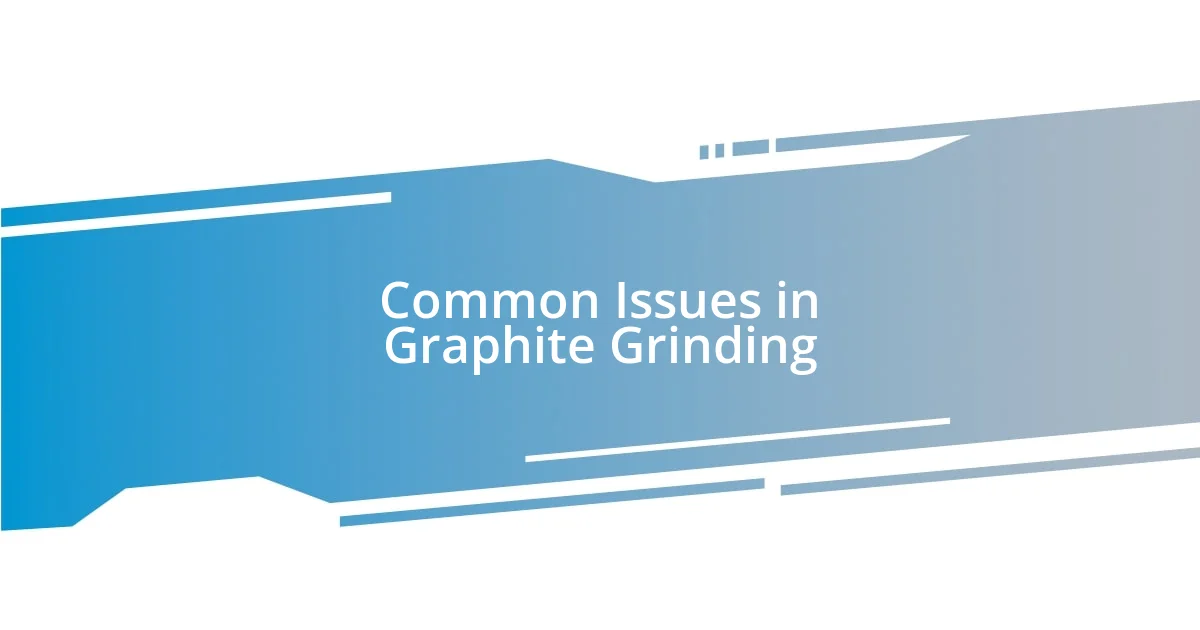
Common Issues in Graphite Grinding
While grinding graphite seems straightforward, several common issues can easily derail your efforts. One challenge I frequently encountered early in my grinding journey was inconsistent particle size. It’s surprisingly frustrating when you think you’ve nailed the technique, only to find a mix of coarse and fine particles in the end. This inconsistency often stems from improper speed settings or not using the right amount of pressure—what a learning curve that has been for me!
Another hurdle I faced was overheating during the process. I remember the first time I overlooked the buildup of heat; my graphite turned into a sticky mess that clung to the blades. It was a classic case of “too much of a good thing” as higher RPMs often meant more heat, which negatively affected the material’s properties. This experience taught me the importance of monitoring not just how fast, but also how consistently I grind—not something I took for granted ever again!
Lastly, dust control is a persistent issue that can’t be ignored. I used to think a dust collection system was merely a bonus, but I quickly learned it’s essential. The clouds of graphite dust not only made my workspace chaotic, but it also affected the quality of my work, introducing unwanted contaminants into my final product. I vividly remember the first time I invested in a better filtration system; the difference was palpable. Has anyone else felt that sigh of relief when you finally tackle an annoying issue?

Best Practices for Optimal Results
When it comes to achieving optimal results in graphite grinding, I’ve found that setting up the workspace is crucial. For instance, I always make sure my tools and materials are organized before starting; a clutter-free space helps me concentrate and keeps my workflow efficient. Have you ever tried to work in a disorganized area? It can feel overwhelming, right? By taking a moment to prepare, I can focus entirely on the grinding process, allowing my creativity to flow.
Another best practice I swear by is testing my grinding setup before committing to a larger batch. I remember a project where I dove straight into grinding several pounds of graphite without a trial run. The result was a coarse mess that took ages to correct. Now, I always make a small test batch first; this allows me to adjust settings without wasting time or materials. It’s that little extra step that saves me from frustration later on, and I can’t recommend it enough.
Finally, I’ve learned the power of patience. Early on, I was eager to finish quickly and often rushed the grinding process, leading to subpar results. One memorable experience was when I tried to cut corners and ended up with inconsistent particle sizes. That taught me that taking my time not only yields better quality but also gives me a chance to appreciate the artistry of the grinding process itself. Isn’t it amazing how quality can genuinely outweigh quantity?
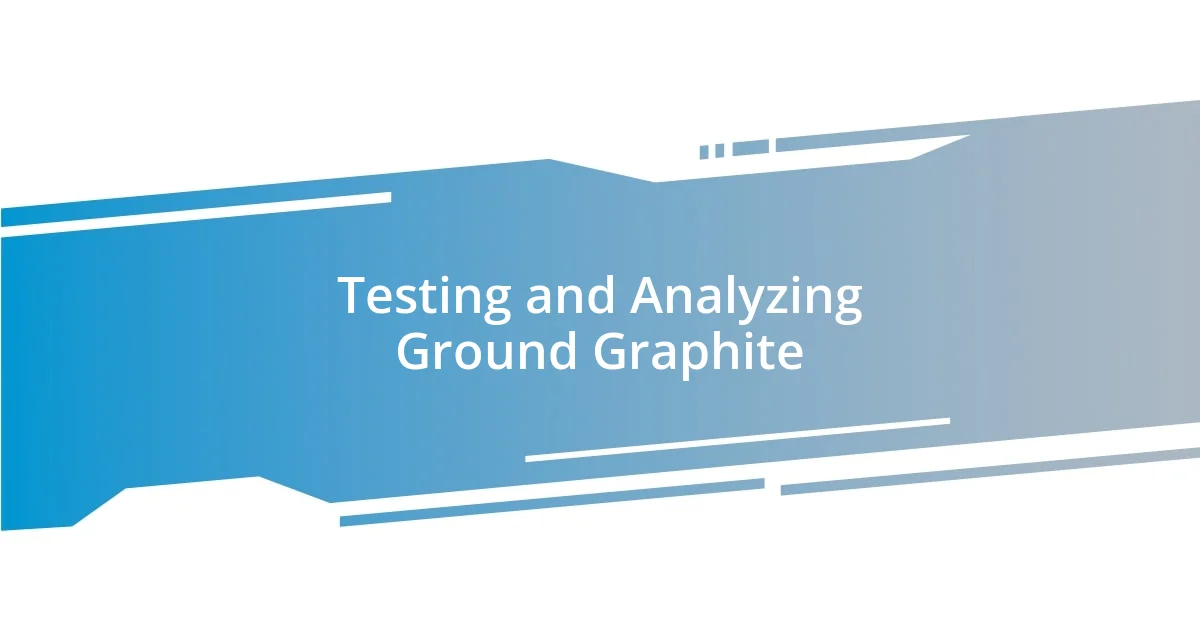
Testing and Analyzing Ground Graphite
Testing ground graphite is an essential part of my process. I often find myself sifting through the results after a grind to check for consistency. One time, I was nearly ready to use a batch for an important project, only to find that the finer particles had clumped together. That moment reinforced how critical regular sampling is.
When analyzing the properties of ground graphite, I focus on metrics like purity and particle size distribution. I recall a particular instance where I decided to use a laser diffraction analyzer. Watching the data come in was intriguing—it provided a clearer picture than I expected. I learned that investing in quality testing equipment pays off; it allows me to fine-tune my technique based on solid data rather than guesswork.
Another key aspect I examine is the visual texture of the ground graphite. I’ve judged batches just by their appearance before and have regretted those hasty decisions. I remember a time when I dismissed a batch because it looked slightly irregular, but later, it turned out to be perfect for a specific application. Isn’t it fascinating how trusting our instincts can often lead to unexpected successes?
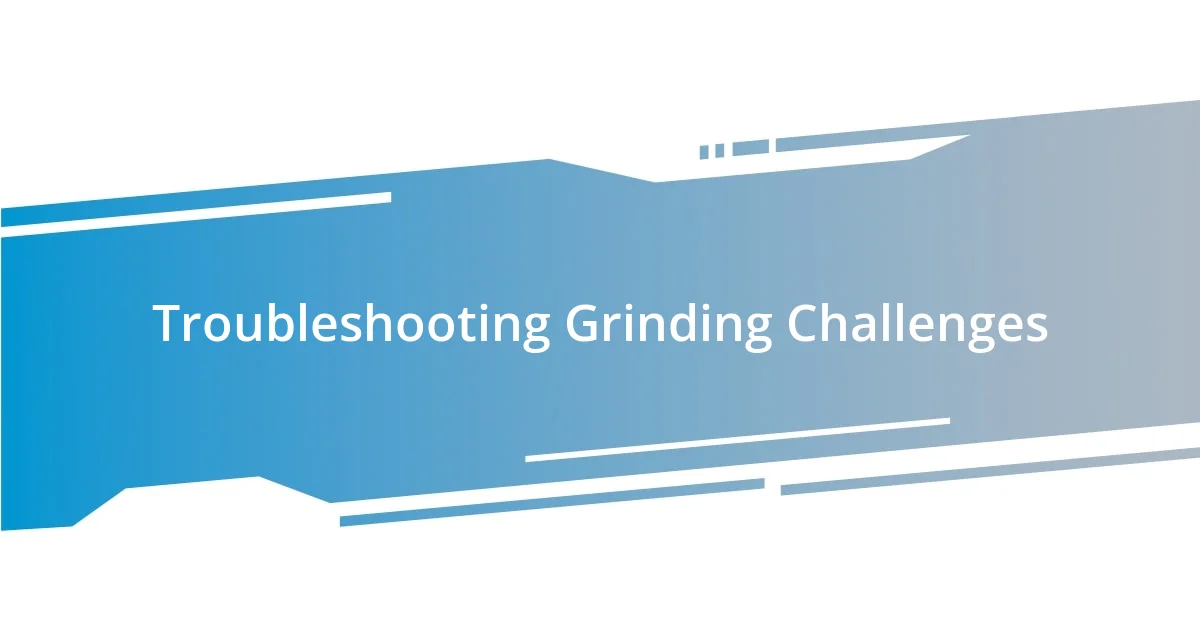
Troubleshooting Grinding Challenges
When troubleshooting grinding challenges, I often find that unexpected noises from the grinder can be a telltale sign of issues brewing beneath the surface. I once had a grinding session where the machine started to rattle—my instinct kicked in, urging me to pause. I discovered that a loose blade was causing the disturbance. Have you ever ignored a machine’s warning signs? It’s worth taking a moment to investigate before moving forward.
Sometimes, the consistency of the ground graphite isn’t where I expect it to be. I remember a bout of frustration when I noticed an uneven texture that simply didn’t align with my previous batches. After some reflection, I realized that minor adjustments to my feeding speed could significantly improve uniformity. It’s curious how something so simple can have such a dramatic impact, isn’t it?
In addition to mechanical issues, environmental factors can also screw up the grinding process. I once worked in a humid space, which led to clumping that I hadn’t anticipated. I learned that keeping an eye on the humidity levels is pivotal. It makes me wonder how much we underestimate the environment’s role in our craftsmanship. Have you checked the conditions of your workspace lately? Making a few environmental tweaks can transform your results.












